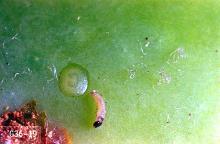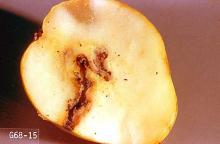Cydia pomonella
Pest description and crop damage This insect can be the worst pest of pears, especially in warmer, drier areas of the PNW. Adult moths have a 0.5 to 0.75 inch wingspan, with alternating gray and white bands on the wings and a copper band on the wing tips. Larvae are whitish with a black head when immature, and pinkish with brown heads when mature. Larvae are 0.1 inch long at hatch and 0.8 inch in length at maturity. Pupae are brown and about 0.75 inch in length. The eggs are small and usually laid singly. Larvae feed directly on the fruit by boring into it and feeding within. Minor damage "stings" can also occur, which are shallow depressions where feeding occurred and stopped. Larvae that bore into the fruit leave characteristic bore holes on the exterior, filled with frass which extrudes from the hole. Bartlett pears are the most susceptible to codling moth injury, especially early in the season. Most of the early season injury on pears will be through the calyx of the fruit. All pear cultivars become more susceptible to codling moth injury later in the season.
Biology and life history Codling moths overwinter as mature larvae in silken cocoons spun under loose bark on the tree, in the soil, and detritus at the base of the tree, or on other surfaces such as fruit packing bins. Pupation takes place in the spring around the time the first blossoms are showing pink, and adults emerge around bloom. Adults are active only at dusk and dawn and lay eggs on leaves and fruit. The larvae emerge, begin feeding on fruit, and will bore to the center of developing fruit to feed on the flesh and seeds. As they mature, they push frass out of the entry hole. After three to four weeks, the larvae leave the fruit to seek a sheltered spot on the tree to spin cocoons. The larvae may overwinter in the cocoon, or they may emerge in two to three weeks as a new flight of adults. These adults are active in July and August. In warm areas, there may even be a third brood. Larvae of this brood often penetrate fruit but do not complete development before harvest or winter.
Pest monitoring Codling moth populations can be monitored using pheromone traps, and predicted with phenology models. Before the pink stage, place lure baited traps in the upper canopy of trees where you expect damage. Catches in the traps determine the biofix date, which is the first capture of multiple male moths (2-3) in a trap or consistent capture of multiple males over more than one trap. The biofix date is used as the point to start accumulating degree-days for the Stanley and Hoyt (1987) degree-day model, which is the best model for PNW locations south of 46°N. North of this latitude, the no-biofix model can be used (Jones et al. 2008).
Early season control of the first generation with oils or insecticides that target eggs and newly emerged larvae, is the most effective strategy for preventing population growth. This timing is around 250 degree-days after biofix. If mating disruption is used, monitor the orchard with traps baited with 10-mg pheromone lures or combination pheromone/pear ester lures set in the upper third of the canopy. Continue to monitor throughout the season. If more than five moths are captured in a trap over the first generation, check the orchard for fruit damage and, if needed, apply a conventional insecticide. If fruit damage exceeds 0.1% at the end of the first generation, use conventional insecticides to control the second generation. The use of phenology models can help predict specific life stages and subsequent generations of the codling moth so that insecticides can be timed for the most susceptible life stage, which is after egg hatch and prior to larvae entering the fruit.
Management-cultural control
Black-light traps have shown some efficacy in small orchards for trapping the adult moths. Remove any infested fruit well before harvest, and destroy them to eliminate larvae. Remove brush and debris from the orchard, and remove bark scales from the tree to eliminate overwintering sites. Wrap the trunk with corrugated cardboard or burlap to trap migrating larvae. Periodic removal of these tree wraps to destroy cocooning larvae can help to reduce the population and limit subsequent fruit damage. Thinning fruit clusters to singles will aid in limiting codling moth entries. Exclusion netting, in the form of individual mesh fruit-bags or whole tree netting, can be used to prevent egg laying.
Management-biorational control
Mating disruption is widely used as the foundation of integrated pest management strategies in commercial orchards. Hand applied dispensers (Isomate, No Mate, CheckMate, Disrupt) at 400 dispensers/A, or aerosol emitters (CheckMate Puffer, Isomate CM Mist) at one unit/Acre are the recommended rates to attain good control. Most formulations are OMRI-listed for organic use. Mating disruption is not effective when used in home orchards or on small plantings. A sprayable formulation for dispensing pheromone is also available (CheckMate CM-F).
Pheromone dispensers must be placed in the tree before first moth flight; this usually is around full bloom on 'Delicious' apples. Place hand applied dispensers high in the top of the canopy. Aerosol emitters can damage leaves and fruit when pheromone formulation is sprayed directly onto tree.
If the orchard has a history of codling moth problems, use conventional insecticide sprays against the first generation. If a codling moth source exists nearby, use border sprays (five to six rows) of conventional insecticides.
Management-biological control
Codling moth granulosis virus (Cyd-X, Cyd-X HP, Virosoft CP4)-Check labels for rates. REI 4 hr. PHI 0 days. Most formulations are OMRI-listed for organic use. Granulosis virus, a selective biological insecticide, must be ingested to be effective. Thorough coverage is important. The virus degrades when exposed to UV light. Frequent applications (seven to fourteen days) may be necessary, especially when codling moth pressure is high. Sprays of Bacillus thuringiensis (Bt) have not proven effective.
Management-chemical control: HOME USE
After petal fall spray and spring and summer sprays
Apply first cover spray at 250 degree-days after biofix, or about ten days after full petal fall (all petals are off) or 17 to 21 days after full bloom. Insecticides must be timed to target newly hatched larvae before they bore into the fruit. Multiple sprays are often necessary with applications up to every 10 to 14 days, however sprays can be reduced by monitoring for adult moths with pheromone traps or the use of degree-day models to properly time insecticide applications to the hatching larvae during the growing season. In fruit growing regions, Extension offices may also have data on biofix dates.
- acetamiprid-Toxic to bees.
- bifenthrin-Highly toxic to bees.
- carbaryl-Highly toxic to bees.
- gamma-cyhalothrin-Highly toxic to bees.
- insecticidal soap-Some formulations are OMRI-listed for organic use.
- kaolin-Applied as a spray to leaves, stems, and fruit, it acts as a repellant to some insect pests. Some formulations are OMRI-listed for organic use.
- lambda-cyhalothrin-Highly toxic to bees.
- malathion-Highly toxic to bees.
- permethrin-Highly toxic to bees.
- pyrethrins-Highly toxic to bees. Some formulations are OMRI-listed for organic use.
- spinosad-Some formulations are OMRI-listed for organic use.
- zeta-cypermethrin-Highly toxic to bees.
Management-chemical control: COMMERCIAL USE
In major fruit-growing areas, spray notices are sent from local Extension offices.
- acetamiprid (Assail 70WP) at 1.7 to 3.4 oz/A (0.075 to 0.15 lb ai/A). REI 12 hr. PHI 7 days. Do not exceed 4 treatments per calendar year. Do not apply more than once every 12 days. Do not exceed 0.60 lb ai (13.5 oz product) /A per calendar year. Repeated use may induce spider mite buildup.
- chlorantraniliprole (Altacor) at 3 to 4.5 oz/A. REI 4 hr. PHI 5 days. Do not exceed 9 oz/A per season. Use 4 to 4.5 oz/A when codling moth pressure is high.
- cyantraniliprole (Exirel) at 10 to 17 fl oz/A. REI 12 hr. PHI 3 days. Do not exceed three applications per season.
- diazinon (Diazinon 50W) at 1 lb/ 100 gal per A (100 gal/A min). REI 4 days. PHI 21 days. Apply as a cover spray when infestation occurs. Do not exceed one in-season foliar application per year. Applicators must use an enclosed cab, see label for details.
- diflubenzuron (Dimilin 2L) at 12 to 16 fl oz product in at least 80 gal water/A. REI 12 hr. PHI 14 days. Use against low to moderate pest pressure in conjunction with codling moth mating disruption. Adding 1% horticultural mineral oil to early season applications increases efficacy on codling moth. See label for application timing. Complete coverage is necessary for optimal control.
- indoxacarb (Avaunt 30WDG) at 6 oz/A. REI 12 hr. PHI 28 days. Apply in spray volume of 200 gal/A or less. Use against low to moderate pest pressure in conjunction with alternate control measures such as mating disruption.
- methoxyfenozide (Intrepid 2F) at 16 fl oz/A. REI 4 hr. PHI 14 days. Use against low to moderate pest pressure in conjunction with alternative control measures such as mating disruption. See label for application timing. Do not exceed 64 fl oz/A per season.
- novaluron (Rimon 0.83EC) at 32 fl oz/A. REI 12 hr. PHI 14 days. Do not apply after pear turn-down. For use on pears only in Colorado, Michigan, New York, Pennsylvania, Washington and Oregon.
- phosmet (Imidan 70W) at 3.5 to 5.75 lb/A. REI 7 days. PHI 7 days. Do not exceed 16 lb/A per season.
- pyriproxyfen (Esteem 35WP) at 4 to 5 oz/A. REI 12 hr. PHI 45 days. Use against low to moderate pest pressure in conjunction with alternate control measures such as mating disruption. Adding 1% oil increases Esteem's efficacy on codling moth. See label for application timing. Do not exceed two applications per season.
- spinetoram (Delegate WG) at 1.5 to 1.75 oz/100 gal water (6 to 7 oz/A). REI 4 hr. PHI 7 days. Do not exceed four applications or 28 oz/A per season. Do not make over three consecutive applications.
- spinosad (Entrust SC) at 6 to 10 oz/A. REI 4 hr. PHI 7 days. Do not exceed 29 oz/A per year. OMRI-listed for organic use.
Resistance management Avoid treating consecutive generations of codling moth with the same material or materials with the same mode of action. Alternate pesticides with different chemistries and modes of action.




